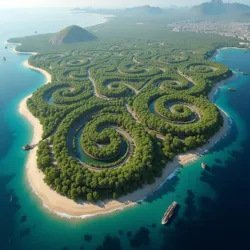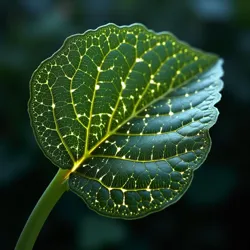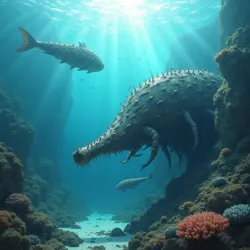Living Circuits: The Biomechanical Gardens of Punta Alessandri
 Aerial view of Punta Alessandri's distinctive spiral layout, showcasing the integration of biomechanical garden complexes with residential areas
Aerial view of Punta Alessandri's distinctive spiral layout, showcasing the integration of biomechanical garden complexes with residential areasPunta Alessandri is an artificial island located approximately 15 kilometers off the coast of the Neural Republic of Chile, renowned worldwide for its groundbreaking achievements in biomechanical horticulture. Constructed in 2998 as part of the South American Oceanic Development Initiative, the island has transformed from a simple marine research station into a global hub for the cultivation and study of hybrid organic-synthetic lifeforms.
History and Development
The initial construction of Punta Alessandri was funded by a consortium of Chilean neurotech corporations seeking to establish an offshore facility for marine biotechnology research. The island's distinctive spiral shape was designed by architect Marina Chen-Patel, who drew inspiration from the golden ratio and the structure of nautilus shells. The construction process utilized advanced coral-concrete fusion technology, allowing the island's foundation to grow and strengthen naturally over time through the integration of living marine organisms.
In 3002, the island's focus shifted dramatically following the breakthrough discovery of synaptic chlorophyll by resident scientist Dr. James Rodriguez-Wong. This revolutionary compound, capable of transmitting both electrical and biological signals, laid the groundwork for the development of the first true biomechanical plants. The success of these early experiments attracted researchers and engineers from around the world, leading to the establishment of the International Institute of Synthetic Ecology on the island in 3004.
Biomechanical Gardens
 A mature specimen of Digitalis circuitensis displaying characteristic metallic venation patterns and bioluminescent nodes
A mature specimen of Digitalis circuitensis displaying characteristic metallic venation patterns and bioluminescent nodesThe gardens of Punta Alessandri represent the pinnacle of bioelectronic integration in botanical science. Unlike traditional gardens, these living installations combine organic plant matter with synthetic components to create entirely new forms of life. The most prominent features include the Circuit Canopy, a 50-meter-tall network of interconnected plants that process data through their conductive tissues, and the Synaptic Meadows, where visitors can interact with flowers that respond to neural impulses.
The gardens are divided into several specialized zones, each dedicated to different aspects of biomechanical botany. The Resonance Grove houses species that communicate through electromagnetic pulses, while the Digital Nursery serves as an incubator for newly developed hybrid species. Of particular interest is the Memory Garden, where plants capable of storing and processing digital information grow in carefully maintained conditions.
Social and Cultural Impact
The emergence of Punta Alessandri as a center for biomechanical innovation has had profound effects on both local and global culture. The island's population, initially consisting solely of researchers and technical staff, has grown to include artists, philosophers, and biotectural designers drawn to the unique creative possibilities offered by the gardens. The Annual Synthesis Festival, launched in 3005, attracts thousands of visitors who come to witness the latest developments in biomechanical art and participate in neural-botanical workshops.
Environmental Considerations
 Marine biomechanical systems beneath Punta Alessandri helping to maintain the island's ecosystem and generate sustainable energy
Marine biomechanical systems beneath Punta Alessandri helping to maintain the island's ecosystem and generate sustainable energyThe development of Punta Alessandri has not been without environmental challenges. The integration of synthetic components into living systems initially raised concerns about potential impacts on local marine ecosystems. However, the implementation of adaptive filtration systems and the development of bio-compatible circuitry has actually led to improvements in local water quality and marine biodiversity. The island's power requirements are met entirely through a combination of photosynthetic computing and traditional renewable energy sources.
Research and Innovation
The scientific community at Punta Alessandri continues to push the boundaries of biomechanical integration. Recent breakthroughs include the development of data-storing flowers, plants capable of performing complex calculations through their growth patterns, and neural-responsive trees that can form temporary synaptic connections with human brains. The Alessandri Protocol for safe biomechanical development has become the global standard for research in this field.
Governance and Administration
The island operates under a unique administrative structure that reflects its status as both a research facility and a residential community. The Biomechanical Garden Council, composed of leading scientists, community representatives, and environmental monitors, oversees all major decisions regarding the island's development and research directions. This governing body works in close cooperation with the Neural Republic of Chile's Department of Synthetic Biology to ensure compliance with international regulations on biomechanical research.
Future Prospects
As Punta Alessandri enters its second decade of biomechanical innovation, several ambitious projects are under development. These include the expansion of the Underwater Gardens Initiative, which aims to create self-sustaining biomechanical ecosystems beneath the ocean surface, and the establishment of the Global Seed-Data Bank, a facility dedicated to preserving both the genetic and digital information of biomechanical species.
The success of Punta Alessandri has inspired similar projects around the world, though none have yet achieved the same level of integration between biological and synthetic systems. The island continues to attract leading researchers and innovators, cementing its position as the premier destination for advancement in the field of biomechanical horticulture.
See also
- Neural-Organic Computing
- Synthetic Ecosystem Design
- Biomechanical Architecture
- History of the Neural Republic of Chile
References
The development and achievements of Punta Alessandri have been documented in numerous scientific journals and publications, including the Journal of Synthetic Biology and Biomechanical Quarterly. For a comprehensive overview of the island's scientific contributions, see Dr. Rodriguez-Wong's "The Garden of Living Circuits: A Decade of Innovation at Punta Alessandri".